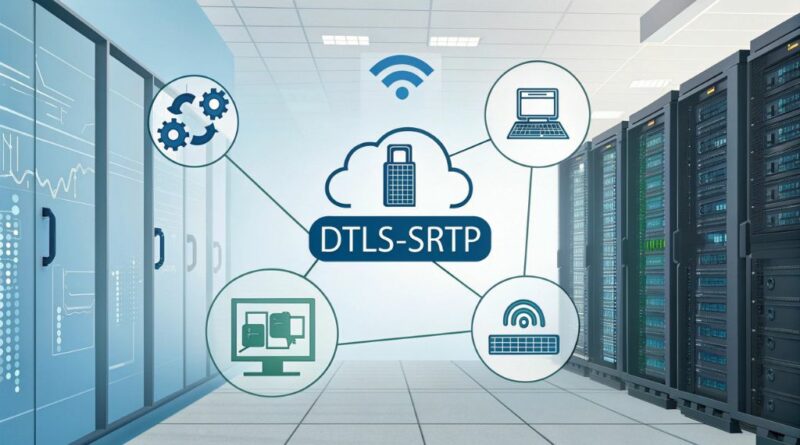How DTLS-SRTP Keeps WebRTC Voice and Video Secure
When you make a browser-based call or join an online meeting, you probably don’t give much thought to how your audio and video stay private. Yet behind every WebRTC session is a powerful encryption framework that ensures your data can’t be intercepted.
That framework is called DTLS-SRTP — a combination of protocols that form the security backbone of modern real-time communication.
In this article, we’ll explore what DTLS-SRTP is, how it works, and why it’s critical to keeping VoIP and WebRTC secure.
The Basics: Why Encryption Matters in WebRTC
WebRTC (Web Real-Time Communication) enables browsers and mobile apps to share audio, video, and data streams without installing extra software.
But because WebRTC operates across the open internet, encryption is non-negotiable. Every packet of voice or video could otherwise be exposed to attackers, service providers, or even compromised routers along the way.
👉 Official WebRTC Security Overview
That’s where DTLS-SRTP (Datagram Transport Layer Security with Secure Real-Time Protocol) comes in — it protects WebRTC traffic from eavesdropping and tampering.
Breaking Down DTLS-SRTP
DTLS-SRTP is not a single technology, but a combination of two complementary standards:
- DTLS (Datagram Transport Layer Security) – encrypts signalling and handshake data, securing the negotiation between peers.
- SRTP (Secure Real-Time Transport Protocol) – encrypts the actual voice and video packets once the connection is established.
The pairing allows WebRTC to exchange encryption keys securely and protect every subsequent media frame.
👉 IETF RFC 5764 – DTLS-SRTP Specification
How It Works in a Typical WebRTC Session
When you start a WebRTC call, your browser and the peer device perform a DTLS handshake.
- Handshake Initiation – Each peer generates encryption keys.
- Certificate Exchange – They verify each other’s digital identity (self-signed certificates are allowed).
- SRTP Session Setup – Once authenticated, DTLS hands the keys to SRTP, which encrypts the voice and video streams.
From that point forward, all communication occurs through encrypted SRTP packets, making it nearly impossible for anyone to intercept or modify the data.
The Advantages of DTLS-SRTP
1. End-to-End Encryption
Every packet transmitted between users is encrypted independently of intermediaries. Even if media passes through relay nodes (like TURN servers), they can’t decrypt it.
2. No Pre-Shared Keys
Unlike older VoIP standards that used fixed keys or centralised security, DTLS dynamically negotiates new keys for each session — eliminating long-term exposure.
3. Built for the Web
Because DTLS runs over UDP (unlike traditional TLS, which runs over TCP), it’s optimised for low-latency, real-time communication. Perfect for voice and video.
👉 Mozilla Developer Docs – SRTP Overview
DTLS-SRTP in VoIP and PBX Ecosystems
DTLS-SRTP isn’t exclusive to WebRTC — it’s also supported by modern VoIP and PBX systems that need encrypted media transport.
For example:
- Asterisk and FreeSWITCH both include DTLS-SRTP support for WebRTC endpoints.
- Cloud PBX providers use it to secure browser extensions and softphones.
This has become a major differentiator for VoIP providers competing on security and compliance.
👉 Asterisk WebRTC Configuration Guide
How It Compares to Traditional SIP Encryption
Traditional SIP systems often relied on TLS + SRTP, where TLS encrypted only the SIP signalling and SRTP handled the media.
WebRTC’s use of DTLS-SRTP merges these layers, creating a simpler, more unified model. It also removes the need for separate signalling servers — making it easier to deploy encrypted systems that scale.
Common Challenges in Deployment
While DTLS-SRTP is incredibly secure, implementing it correctly can be tricky:
- Certificate Validation: Some systems skip verification, creating potential weaknesses.
- NAT Traversal: When peers are behind firewalls, extra care must be taken to maintain key exchange integrity via ICE.
- Interoperability: Older SIP devices without DTLS support need a gateway to translate between TLS-SRTP and DTLS-SRTP.
Open-source tools such as Janus Gateway, OpenSIPS, and Kamailio make this process much easier — providing built-in encryption handling and diagnostic utilities.
The Future: Post-Quantum and Advanced Encryption
With cyber threats constantly evolving, researchers are already exploring post-quantum encryption for WebRTC. Future versions of DTLS could include hybrid algorithms that remain secure even against quantum computing attacks.
At the same time, newer browsers continue to tighten requirements for certificate handling, ensuring WebRTC security stays modern and transparent.
Conclusion
DTLS-SRTP might not be something most users ever think about — but without it, secure communication on the web would simply not exist.
It’s the invisible guard protecting billions of WebRTC calls each day, ensuring that voice, video, and data remain confidential.
As remote collaboration, browser softphones, and cloud PBX systems continue to expand, DTLS-SRTP will remain the foundation of trust in real-time communication.
For more articles like this, visit SoftpageCMS.



